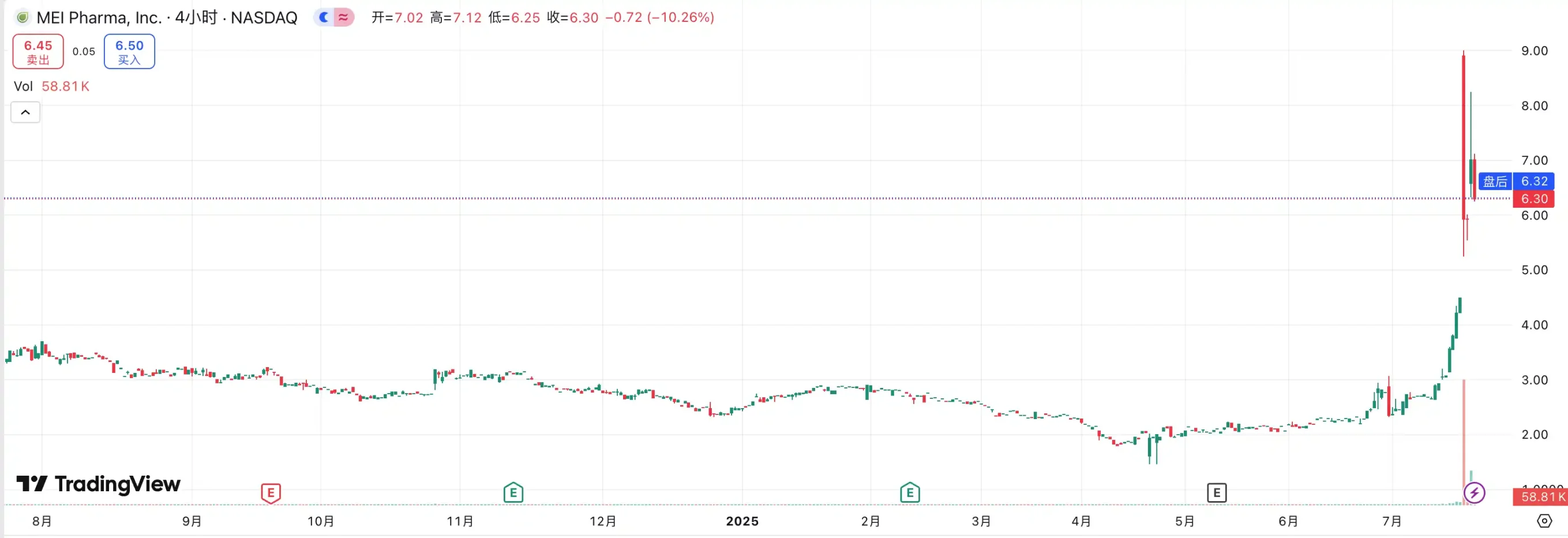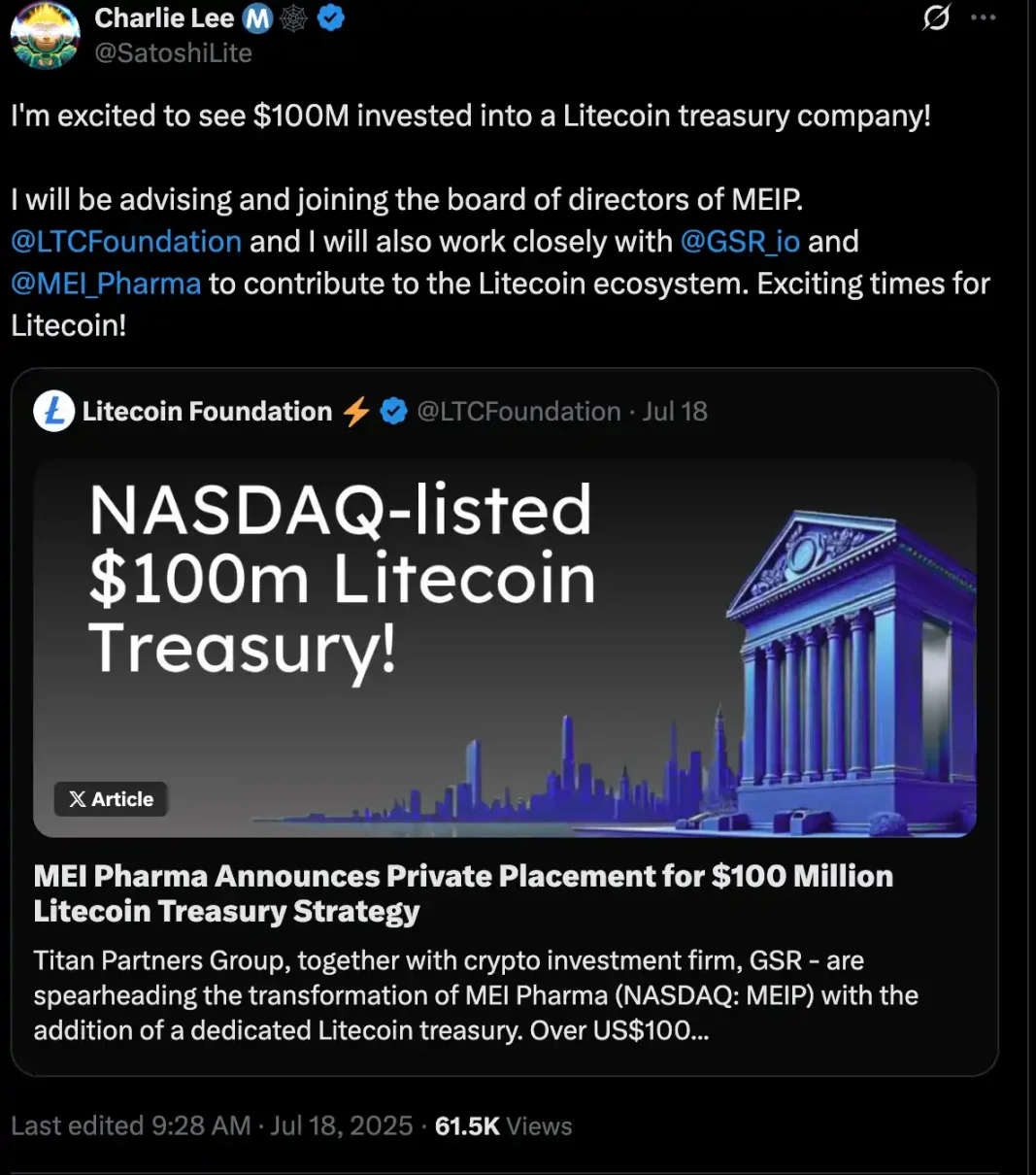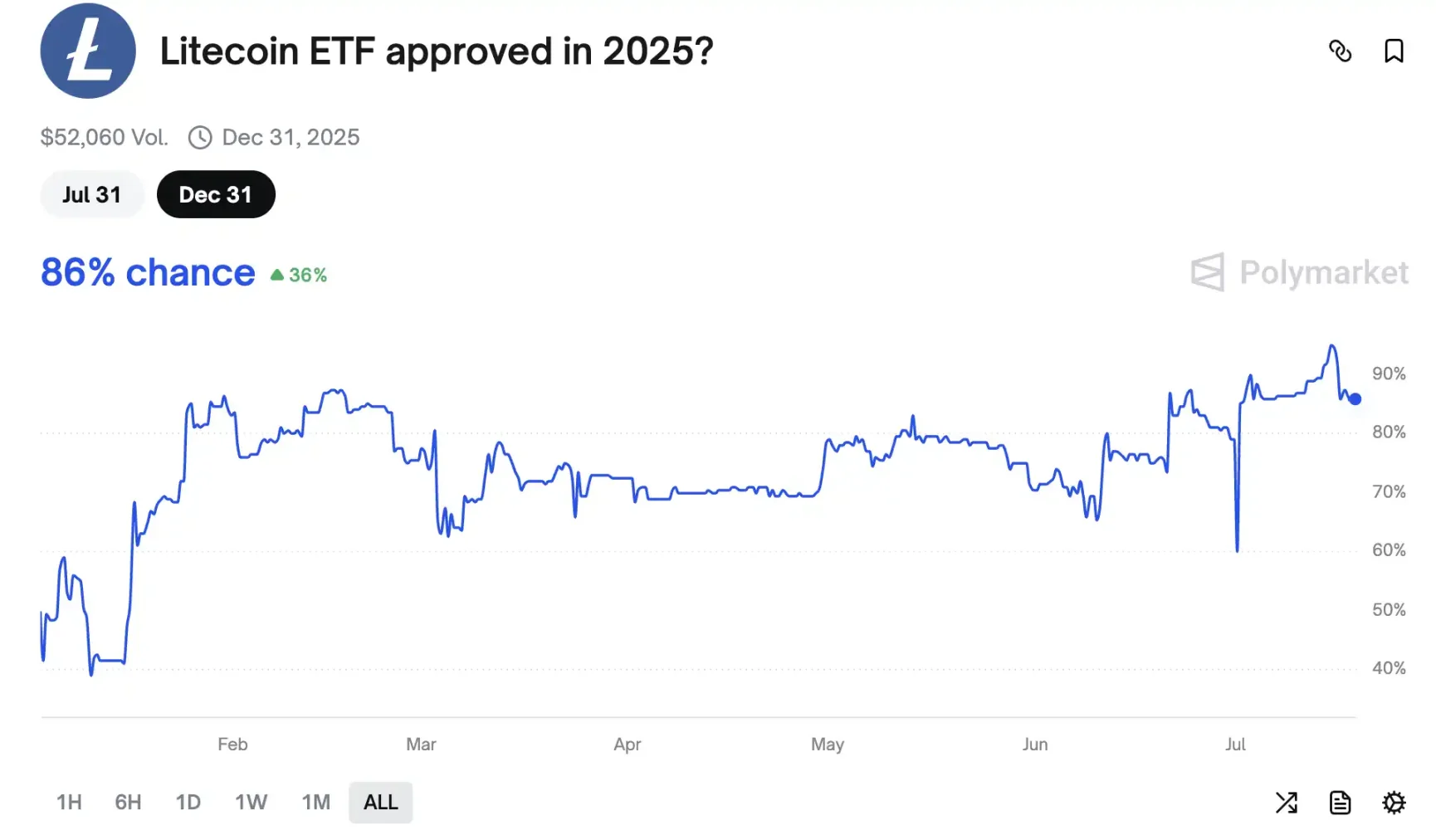LTC Takes the Wall Street Stage: MEI Pharma's "Litecoin Vault" Rises Over 80%
Written by: KKK
On July 19, MEI Pharma (ticker: MEIP), an American pharmaceutical company, announced a strategic transformation that pushed for its strategy to establish a dedicated Litecoin vault. More than $100 million has been committed to the project.
As part of the deal, the biotech company will appoint Litecoin founder Charlie Lee to its board of directors. GSR will also receive a seat on the board and hold a key position on the company's Digital Asset and Treasury Management Advisory Committee. Additionally, the Litecoin Foundation has invested in MEI Pharma, as the company's treasury strategy aligns closely with the Litecoin Foundation's core mission to drive global Litecoin adoption.
Following the announcement, MEIP shares surged 83.37% in pre-market trading on Friday, extending the previous day's 16.58% gain, reaching a high of $9 and currently stabilizing at $6.30. The trading volume on the day exceeded 13 million shares, far exceeding the daily average of 26,000 shares in the past three months. This change not only reflects the market's positive expectations for the company's blockchain transformation, but also marks the official launch of another "altcoin microstrategy" model after mainstream crypto assets such as ETH, SOL, BNB, etc., and Litecoin (LTC) ushered in a new chapter in institutional allocation.

MEI Pharma completes its strategic transformation: the first publicly traded company to establish a strategic reserve of Litecoin
MEI Pharma, Inc. is a biopharmaceutical company focused on the research and development of small molecule drug compounds, and its core R&D programs include Voruciclib, a CDK inhibitor for the treatment of B-cell malignancies, and ME-344, a mitochondria-targeted anticancer drug. The company was founded on December 1, 2000 and is headquartered in San Diego, California, USA.
On July 19, 2025, MEI Pharma announced that it would integrate with blockchain finance, launch a new round of private equity investment (PIPE) transactions, and plan to include Litecoin (LTC) in its corporate asset allocation, becoming the first listed biotechnology company to use LTC as its main financial reserve asset.
According to the announcement, the round of financing, jointly led by Titan Partners Group and cryptocurrency trading firm GSR, plans to issue 29,239,767 common shares or equivalent prepaid warrants at $3.42 per share, with a total financing size of approximately $100 million. The transaction is expected to close on or about July 22, 2025, subject to customary regulatory and closing conditions.
Behind this financing is not only a capital operation, but also indicates that MEI is undergoing a deep strategic transformation. The company said it had previously systematically evaluated the sustainability of traditional biotechnology business models and decided to embrace the blockchain and decentralized finance (DeFi) fields, planning to restructure its corporate treasury with Litecoin as its core asset, and launch long-term cooperation with the Litecoin Foundation and GSR.
In response to the partnership, Charlie Lee said, "Since its inception in 2011, Litecoin has always adhered to the concept of fast, secure, and decentralized. It's great to see that public companies like MEI are embracing these principles. This not only reflects the growing institutional confidence in LTC, but also lays the foundation for its further expansion in traditional capital markets."

Why Litecoin?
Litecoin, one of the first altcoins to enter the market, was created in 2011 by former Google engineer Charlie Lee, and its core architecture is based on Bitcoin's open-source code with several optimizations and upgrades based on it. Compared to Bitcoin, Litecoin has faster block generation and uses the Scrypt proof-of-work (PoW) algorithm, which is more suitable for ordinary hardware mining and lowers the barrier to participation. Its total supply is set at 84 million and has a deflationary property similar to Bitcoin, where the block reward halving mechanism is triggered every 840,000 blocks.
As a representative of the first generation of altcoins, Litecoin has always been committed to improving the efficiency and scalability of on-chain transactions, with advantages such as low fees and fast processing speed. In recent years, Litecoin has also gradually expanded its payment usage scenarios, including travel companies, convenience stores, real estate agencies, and online e-commerce. In 2021, the Litecoin Foundation announced a partnership with financial service providers to issue Visa debit cards, enabling users to convert LTC to USD in real-time, completing consumer payments, and further solidifying its practical value.
Since the founding of Litecoin in 2011, Charlie Lee has been a central enabler behind this ecosystem. He not only championed technological innovation but also led several key upgrade processes – including Litecoin's selective integration of privacy features, activation of SegWit, and more. Charlie Lee has also invested heavily in promoting Lightning Network experiments, mining pool collaborations, and developer community building, laying a solid foundation for the long-term development of the Bitcoin and Litecoin networks.
Now, his deep involvement in MEI Pharma's Litecoin vault has once again boosted market confidence in the Litecoin vault strategy. As the Litecoin Foundation emphasized in the announcement: "For 14 years, Litecoin has consistently provided a stable, low-cost, and accessible network to millions of users." This MEI collaboration not only marks the first time Litecoin has been included in the financial structure of a U.S.-listed company, but also a strategically important institutional-level financial experiment with the direct participation of the founders.
Meanwhile, institutional expectations for Litecoin are heating up rapidly. According to data from Polymarket, a decentralized prediction platform, the probability of the U.S. Securities and Exchange Commission (SEC) approving a Litecoin spot ETF is as high as 86% by the end of 2025. This not only reflects investors' optimistic expectations for Litecoin's regulatory prospects, but also reflects its gradual trend towards becoming a "mainstream asset" in the wave of compliance.
Once the spot ETF is approved, Litecoin will become a core target of traditional financial portfolios along with Bitcoin and Ethereum, providing a legal and compliant allocation path for institutional funds. This will enhance LTC's market liquidity and valuation anchorage, while further strengthening its market positioning as a "payment digital asset" and becoming a bridge between the on-chain world and Wall Street funds.

summary
As MEI Pharma became the first listed company to include LTC in its financial reserves, Litecoin also officially joined the institutional position increase camp after mainstream tokens such as Ethereum, BNB, and SOL opened the "micro-strategy mode", announcing the launch of another altcoin "vault path". On the day of the announcement, Litecoin broke through the downward channel strongly, rising more than 6% in 24 hours, and the price rose to $106 at one point, and then continued its rally to $115. This not only marks the revaluation of LTC's asset attributes, but also further strengthens the role of "altcoin microstrategy" as a capital driver in this bull market. Coupled with the acceleration of the ETF concept and institutional position building, the altcoin season is quietly beginning.
